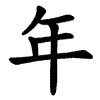年
| ||||||||
| ||||||||
Translingual
| Stroke order | |||
|---|---|---|---|
| Stroke order | |||
|---|---|---|---|
 | |||
Han character
年 (radical 51, 干+3, 6 strokes, cangjie input 人手 (OQ), four-corner 80500, composition ⿱𠂉㐄 or ⿻午⿱一丨 or ⿻午丄)
References
- KangXi: page 340, character 1
- Dai Kanwa Jiten: character 9168
- Dae Jaweon: page 648, character 2
- Hanyu Da Zidian: volume 1, page 37, character 6
- Unihan data for U+5E74
Chinese
Glyph origin
| Historical forms of the character 年 | ||||||||
|---|---|---|---|---|---|---|---|---|
| Shang | Western Zhou | Spring and Autumn | Warring States | Shuowen Jiezi (compiled in Han) | Liushutong (compiled in Ming) | Libian (compiled in Qing) | ||
| Bronze inscriptions | Oracle bone script | Bronze inscriptions | Bronze inscriptions | Chu Slip and silk script | Qin slip script | Small seal script | Transcribed ancient scripts | Clerical script |
 |
 |
 |
 |
 |
 |
 |
 |
 |
In the oracle bone script and early bronze inscriptions, it was originally 秂, an ideogrammic compound (會意) and phono-semantic compound (形聲, OC *niːŋ) : semantic 禾 (“wheat; grain”) + phonetic 人 (OC *njin, “person”) – a person carrying wheat on his back – harvest.
In bronze inscriptions after the Western Zhou period, a stroke was often added to 人 to give 千 (OC *sn̥ʰiːn), which still acted as a phonetic component, and this form (秊) was inherited by later scripts. The current form is inherited from the clerical script, where libian (隸變) has occurred.
Pronunciation
Definitions
年
Usage notes
- Although 年 is the generic term for year, years of age are typically expressed in 歲/岁 (suì), a separate system based on the duodecennial orbital period of Jupiter. Ages in 歲/岁 (suì) are traditionally reckoned using the Chinese lunar calendar, beginning with 1 at the moment of birth and increasing not during birthdays but at the Chinese New Year.
Compounds
|
|
|
Further reading
- “Entry #2298”, in 臺灣閩南語常用詞辭典 [Dictionary of Frequently-Used Taiwan Minnan] (in Chinese and Min Nan), Ministry of Education, R.O.C., 2011.
Japanese
Readings
Compounds
Etymology 1
| Kanji in this term |
|---|
| 年 |
| ねん Grade: 1 |
| on’yomi |
From Middle Chinese 年 (nen, “year”). Compare modern Mandarin reading nián, Hakka ngièn, Cantonese nin4.
See also
| Japanese number-counter combinations for 年 (nen) | ||||
|---|---|---|---|---|
| 1 | 2 | 3 | 4 | 5 |
| 一年 (ichinen) | 二年 (ninen) | 三年 (sannen) | 四年 (yonen) | 五年 (gonen) |
| 6 | 7 | 8 | 9 | 10 |
| 六年 (rokunen) | 七年 (nananen) 七年 (shichinen) |
八年 (hachinen) | 九年 (kyūnen) 九年 (kunen) |
十年 (jūnen) |
| 100 | 1,000 | 10,000 | How many? What year? |
|
| 百年 (hyakunen) | 千年 (sennen) | 一万年 (ichimannen) | 何年 (nannen) | |
Suffix
- a grade, a school year
- 彼は中学2年だ。
- Kare wa chūgaku ni-nen da.
- He's in the second grade in junior high school.
- 1984 February 15, Murakami, Motoka, “1
年 1組 の六 三 四 と嵐 子 の巻 [Class-1 Freshmen, Musashi and Ranko]”, in六 三 四 の剣 [Musashi’s Sword], volume 13 (fiction), Tokyo: Shogakukan, →ISBN, pages 142–144:- な、なんだおまえら⁉
- Na, nan da o-maera⁉
- Wh-Who the hell are you⁉
- Ichinen ichikumi'‼ Natsuki Musashii‼
- Class-1 freshman‼ Natsuki Musashi‼
- Onajiku Todoroki Ranko!
- Same here, Todoroki Ranko!
- な、なんだおまえら⁉
- 彼は中学2年だ。
- a year
- 2008年に橋を建設し始めるようだ。
- Nisen-hachi-nen ni hashi o kensetsu shi hajimeru yō da.
- It seems like they will start constructing the bridge in (the year) 2008.
- 2008年に橋を建設し始めるようだ。
Etymology 2
| Kanji in this term |
|---|
| 年 |
| とし Grade: 1 |
| kun’yomi |
/to2si/ → /tosi/ → /toɕi/
From Old Japanese. Originally referred to grain, particularly rice, and by extension, the year's harvest.[2]
Alternative forms
Noun
Derived terms
Etymology 3
| Kanji in this term |
|---|
| 年 |
| とせ Grade: 1 |
| kun’yomi |
/to2se/ → /tose/
From Old Japanese.[2] Likely a shift in pronunciation from toshi.
Suffix
- (obsolete) used to count years
- c. 759, Man'yōshū (book 5, poem 880), text :
- 阿麻社迦留、比奈尓伊都等世、周麻比都都、美夜故能提夫利、和周良延尓家利
- Amazakaru, hina ni itsu tose, sumahitsutsu, miyako no teburi, wasuraenikeri
- While living five years in the far-remote countryside, I wound up forgetting the manners of the capital
- 阿麻社迦留、比奈尓伊都等世、周麻比都都、美夜故能提夫利、和周良延尓家利
- c. 759, Man'yōshū (book 5, poem 880), text :
References
- 2006, 大辞林 (Daijirin), Third Edition (in Japanese), Tōkyō: Sanseidō, →ISBN
- 1988, 国語大辞典(新装版) (Kokugo Dai Jiten, Revised Edition) (in Japanese), Tōkyō: Shogakukan
Korean
Vietnamese
Han character
年: Hán Việt readings: niên[1][2][3]
年: Nôm readings: năm[1][2][3][4], nên[1][2][3], niên[1][2][4], niền[2]
Compounds
- 十年 (thập niên)
- 少年 (thiếu niên)
- 年少 (niên thiếu)
- 青年 (thanh niên)
References
- Nguyễn (2014).
- Nguyễn et al. (2009).
- Trần (2004).
- Hồ (1976).